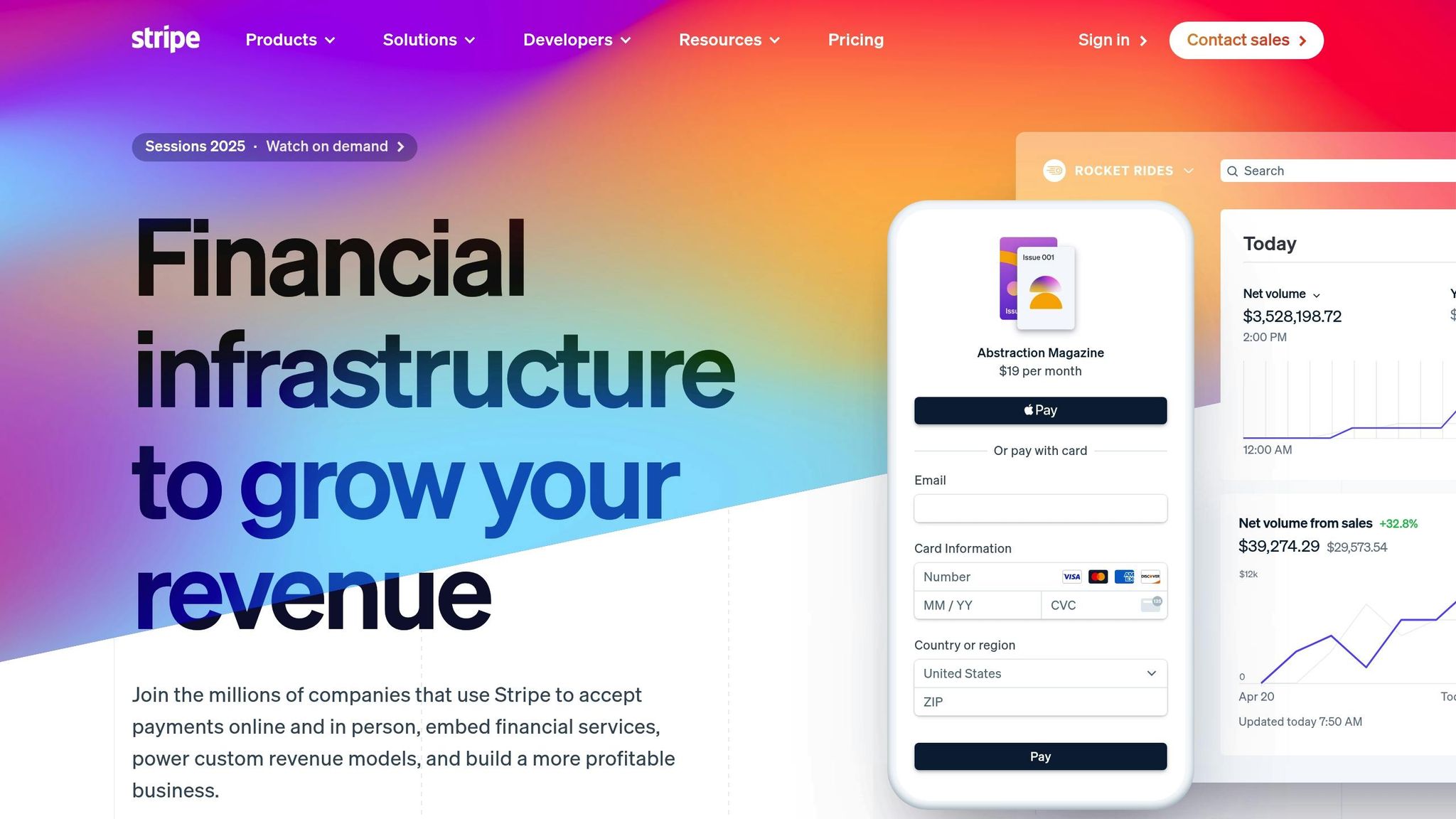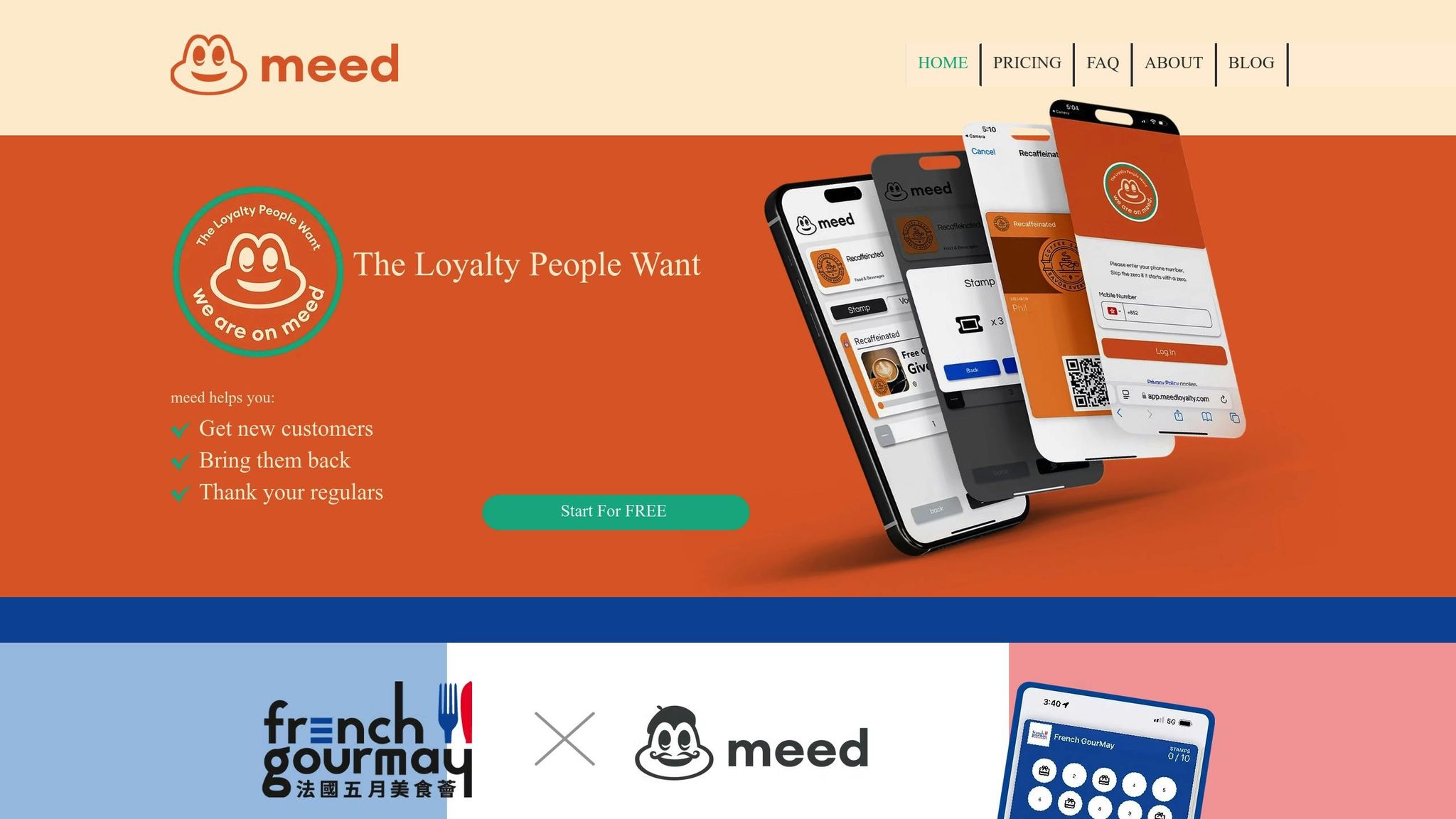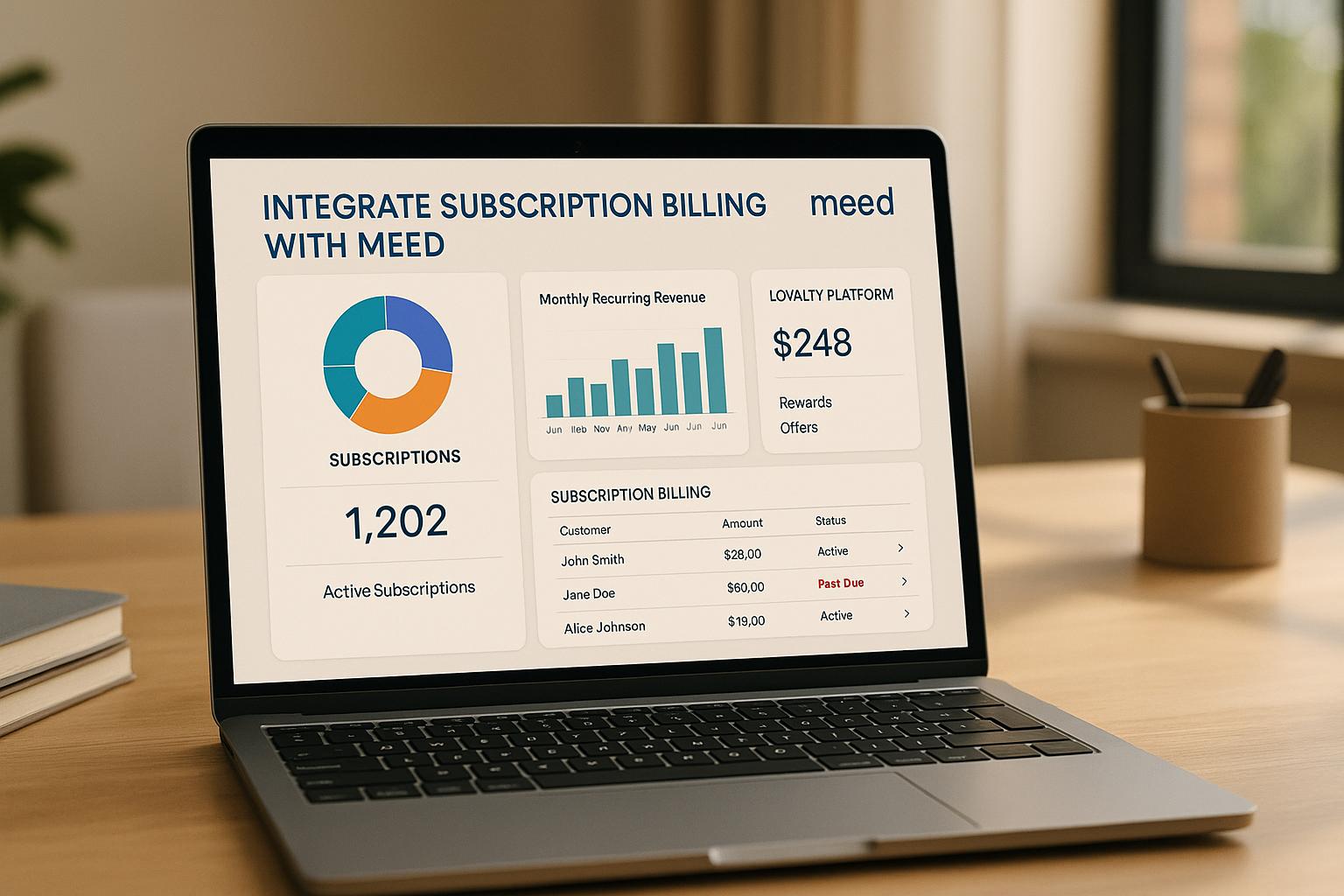Subscription billing is a proven way to generate recurring revenue, and integrating it with Meed’s loyalty platform can take your business to the next level. This guide walks you through the process, from preparing your systems to connecting APIs and linking subscription plans with rewards. Here’s what you need to know:
- Why It Matters: Subscription billing creates predictable income. When paired with Meed, it improves customer retention and engagement through automated rewards and insights.
- Preparation: Ensure your Meed account and billing platform are ready, with admin access, API documentation, and all business details organized.
- Integration Steps: Log in to Meed, connect your billing system (e.g., Stripe), configure webhooks, and map subscription plans to loyalty rewards.
- Testing and Maintenance: Test your setup, monitor performance metrics like MRR and churn, and update settings as needed.
How to Create a Subscription in Stripe (2025) | Recurring Payments with Stripe Subscription Tutorial

Getting Ready for Integration
To ensure a smooth integration process, it’s important to prepare thoroughly. This means confirming all technical prerequisites, organizing your business data, and gathering the tools you’ll need. Additionally, take the time to review both technical and business requirements to set yourself up for success.
Technical Requirements
Begin by ensuring you have an active Meed account with admin access to modify integration settings. Your subscription billing platform should support multiple payment methods and currencies, while also integrating seamlessly with your CRM, ERP, payment gateways, accounting software, and e-commerce platforms. This reduces manual data entry and minimizes errors. Make sure your system administrator has full access to both Meed’s dashboard and your billing platform’s admin panel. This access is crucial for configuring webhooks, setting up API connections, and enabling real-time data synchronization.
Once the technical groundwork is in place, you can focus on aligning your business details with your subscription tiers and loyalty rewards.
Business Information Setup
You’ll need to gather key business details, including your U.S. tax ID, bank account information for payment processing, and your current business registration documents. Additionally, setting up markets and subscription profiles in the Business Configuration section is a required step for integration. This ensures your loyalty rewards are properly aligned with your subscription tiers and customer groups.
Prepare your marketing assets – such as logos, brand colors, and reward rules – to create a customized experience for your customers. Document your existing subscription plans, pricing models, and any loyalty rewards you currently offer. This will help you map your subscription tiers to loyalty benefits effectively.
Integration Tools and Documentation
Having access to comprehensive API documentation and integration tools is essential. For example, Stripe provides API libraries, guides for subscription modeling, registration, and payment testing. Their Payment Element and Checkout API allow you to build custom payment forms, making it easier to handle more complex workflows.
During integration, secure credential management is critical. Store API keys, webhook URLs, and authentication tokens in secure environments, and never expose them in client-side code or unprotected files. Tools like the Stripe CLI can help you test webhooks and make API calls during development. Keep all your integration-related documentation – such as API guides, webhook specifications, and Meed’s integration requirements – organized in a dedicated folder. This will help your team understand the overall architecture and speed up the setup process.
"If there’s one reason we have done better than our peers in the Internet space over the last six years, it is because we have been laser-focused on customer experience, and that does matter, I think, in any business. It certainly matters online, where word of mouth is so very, very powerful." – Jeff Bezos, Founder, and CEO, Amazon.com
Focusing on customer experience is key to ensuring a seamless connection between subscription management and loyalty rewards. By setting up everything properly now, you’ll be well-positioned to manage and grow your integrated subscription and loyalty program efficiently.
Step-by-Step Integration Guide
To integrate your subscription billing system with Meed, you’ll need to access the integration settings, securely connect your API, and align your subscription plans with loyalty rewards. Here’s a detailed guide to help you through the process.
Access Meed‘s Integration Settings

Log in to your Meed dashboard using your admin credentials. Once inside, go to Platform Settings > Gamification > Connectors. This is where you’ll find all the tools needed to link third-party platforms to your loyalty program.
Make sure your account has the necessary admin permissions and is part of the correct Role Group. If you don’t see the "Connectors" option, reach out to your system administrator for assistance.
Keep in mind that gamification connectors are only available with Meed’s Business and Enterprise plans. If you’re on the Starter plan, you’ll need to upgrade. Note that the Starter plan includes full platform access but limits participation to 50 members.
Connect Your Subscription Billing System
Once you’ve accessed the integration settings, it’s time to link your billing system. In the Connectors section, you’ll see options for various payment gateways and billing platforms. Select your subscription billing provider – such as Stripe – and follow the steps to connect.
Enter your API credentials, including the publishable key, secret key, and webhook signing secret. These details will establish a secure link between your billing system and Meed. Make sure to store these credentials securely in Meed’s encrypted settings panel.
Next, configure webhook URLs for real-time data synchronization. This setup ensures that loyalty statuses are automatically updated when subscription payments are processed, renewals occur, or cancellations happen. Be sure to configure endpoints for key events like successful payments, failed transactions, subscription upgrades, and downgrades.
Link Subscription Plans to Loyalty Rewards
After connecting your billing system, the next step is to map your subscription plans to specific loyalty rewards. Use Meed’s API integration to allow real-time data exchange, ensuring each subscription plan corresponds to a particular loyalty reward.
For instance, you could link a basic monthly plan (e.g., $9.99/month) to a bronze loyalty tier, while a premium annual plan (e.g., $99.99/year) might correspond to a gold tier with enhanced perks. To get inspired, consider how Total Tools in Australia structured their Insider Rewards program. They created three tiers – Bronze, Silver, and Gold – offering members exclusive deals, event invites, bonus offers, and monetary rewards.
Test the Integration
Before launching, it’s crucial to test everything thoroughly. Start with a pilot test by rolling out the program to a small group of customers. Then, conduct A/B testing to compare different reward structures, such as percentage-based discounts versus fixed dollar amounts. Additionally, perform usability testing by observing how users interact with the integrated system. These tests will help you identify and fix any issues before going live.
Fix Common Setup Problems
Even with careful planning, you might encounter some common issues during setup. Here are a few troubleshooting tips:
- API and Webhook Issues: If loyalty points aren’t being awarded after payments, double-check your API keys, permissions, and webhook configurations. Look at webhook logs in both systems to identify failed delivery attempts.
- Data Mapping Errors: If subscription plans are linked to the wrong loyalty rewards, review your mapping table and test each plan to ensure accurate connections.
- Timing Problems: Some billing systems send payment confirmation webhooks before the transaction is fully processed. This can cause synchronization issues, so adjust your webhook timing or add verification steps to ensure points are awarded only after confirmed payments.
Finally, ensure all monetary values follow U.S. formatting standards (e.g., $XX.XX) to avoid errors during synchronization.
sbb-itb-94e1183
Managing Your Integration
Once your subscription billing system is linked to Meed, maintaining it effectively is key to getting the most out of your investment. Regular monitoring, updates, and ensuring compliance will keep everything running smoothly while boosting customer engagement and driving revenue. Start by keeping an eye on essential metrics to measure the success of your integration.
Track Performance Data
Meed’s analytics dashboard offers real-time insights into how your subscription billing integration is performing. Keep an eye on critical metrics like Monthly Recurring Revenue (MRR), customer churn rate, Customer Lifetime Value (CLTV), and Average Revenue Per User (ARPU) to assess your business’s overall health.
The dashboard provides a clear overview of your subscriber base, highlighting which subscription plans are thriving and how loyalty rewards are impacting retention. You can customize reports to zero in on specific data points, such as reward redemption patterns or high-performing loyalty tiers.
For instance, StreamFlix experienced a 15% boost in MRR and reduced churn by 10% after leveraging performance tracking.
Use this data to compare your performance against industry benchmarks and pinpoint opportunities for improvement. Look for trends in customer behavior – like which subscription tiers lead to higher retention or which loyalty rewards resonate most with your audience. These insights can guide your decisions on pricing strategies and reward systems.
Update Subscription and Loyalty Settings
Tracking performance is just one part of the equation. Regularly updating your settings ensures your integration evolves with your business strategy and customer needs. When you make changes to subscription plans – whether it’s adjusting pricing, adding new tiers, or altering billing cycles – you’ll need to update the corresponding loyalty rewards in Meed.
Meed’s connector settings also allow you to temporarily suspend accounts at a customer’s request. During these pauses, the system automatically adjusts loyalty point accrual, keeping reward tracking accurate.
To further refine your strategy, consider using A/B testing to evaluate customer engagement. Monitor how changes impact renewal rates and customer satisfaction, and adjust accordingly.
Ensure your system syncs subscription status updates with loyalty program access. For example, unsuccessful payment attempts shouldn’t continue to generate loyalty points. Keeping these processes automated and accurate prevents errors and maintains trust.
Follow U.S. Compliance Rules
Managing subscription billing in the U.S. requires strict adherence to federal and state regulations designed to protect consumers. The FTC’s "Click to Cancel" Rule mandates that canceling a subscription must be as easy as signing up, so your system needs to offer straightforward cancellation options.
Consumer complaints about unclear subscription practices are on the rise. Many people underestimate their subscription spending, believing they spend $86 per month when the actual average is closer to $219. This makes transparency even more vital.
"Nobody should be stuck paying for a service they no longer want." – FTC Chair Lina Khan
Your Meed integration should address these compliance requirements thoroughly. Ensure subscription terms are clearly disclosed at signup, obtain explicit consent before charging customers, and maintain records for at least three years. Keep in mind that state laws may impose stricter rules than federal guidelines, so a robust compliance strategy is essential if you operate in multiple states.
Train your team on these regulations to build trust with customers and avoid penalties. Regularly review and update your disclosures to align with transparency standards, and make sure your cancellation process mirrors the simplicity of your signup process. Additionally, prioritize secure payment processing and data protection, as nearly two-thirds of companies are not PCI-compliant – a risk you can’t afford to take.
Summary and Next Steps
Integrating subscription billing with Meed connects your recurring revenue model to a loyalty platform, creating opportunities for measurable growth. This setup not only enhances customer engagement but also has the potential to significantly improve your bottom line.
Key Outcomes of the Integration
By completing the integration process, you’ve laid the groundwork for meaningful business growth. Even a small improvement in customer retention – just 5% – can lead to profit increases of 25% to 95%. This is particularly important when you consider that 73% of shoppers actively seek to redeem rewards, and 66% say earning rewards influences their spending habits.
The technical setup now in place allows you to track performance effectively, helping you identify which strategies yield the best results. This insight enables you to refine both your subscription plans and rewards structures. The result? A smoother customer experience with fewer friction points. Loyal customers, on average, spend 67% more than new ones, and companies with loyalty programs see revenue grow 2.5 times faster than those without. Additionally, this integration transforms Meed from a simple points system into a comprehensive customer engagement platform that can shape your marketing strategies.
Another key benefit is the robust compliance framework that protects your business and builds trust with customers. As subscription billing regulations grow stricter, your transparency and easy cancellation policies give you a competitive edge over businesses that haven’t yet adapted. These improvements position your business for ongoing success and optimization.
Next Steps to Maximize Results
With your system integrated, the next step is to focus on continuous optimization. Research shows that 80% of consumers are more likely to buy from brands that offer personalized experiences. Use the customer data now flowing through your systems to craft tailored subscription offerings.
Consider implementing tiered pricing models, which can convert up to 20% more customers. Personalized offers and tiered pricing structures not only increase conversion rates but also improve retention. Meed’s analytics can help you identify which subscription levels drive the most loyalty engagement, allowing you to fine-tune your rewards program.
Another strategy to explore is adding loyalty rewards for subscription renewals. Programs that incentivize repeat transactions can boost retention rates by 10-20%. With approximately 75% of subscriptions renewing automatically, layering loyalty incentives onto this process can significantly enhance customer lifetime value.
You might also consider offering exclusive content or products to your subscribers. Research shows that 58% of subscribers would stay subscribed longer if they regularly received exclusive content.
The system you’ve built with Meed puts your business in a strong position to maximize the value of customer relationships. Companies that prioritize increasing customer lifetime value report 30% higher profitability. With the tools and insights now at your disposal, you’re well-equipped to create personalized experiences that keep customers engaged and loyal over the long term.
FAQs
What are the benefits of connecting subscription billing with Meed’s loyalty platform for my business?
Integrating subscription billing with Meed’s loyalty platform brings a host of benefits for small businesses. For starters, it ensures a steady revenue stream through recurring membership fees, while also enhancing customer retention by delivering a smooth and enjoyable experience.
Beyond that, this integration simplifies subscriber management, reduces revenue leaks, and provides valuable insights into customer behavior. These insights can help you design loyalty programs tailored to your audience, increasing customer lifetime value and deepening brand loyalty. By pairing subscription billing with Meed, you can simplify your operations and keep customers engaged with ease.
How do I ensure my subscription billing system complies with U.S. regulations when using Meed?
To make sure your subscription billing system aligns with U.S. regulations while working with Meed, here’s what you need to do:
- Be upfront about subscription terms: Clearly spell out pricing, how often customers will be billed, and the cancellation policies.
- Get clear customer consent: Make sure customers explicitly agree before you process any charges.
- Offer simple cancellation options: Ensure customers can easily manage or cancel their subscriptions without unnecessary hurdles.
It’s also important to keep an eye on federal and state laws, like those enforced by the FTC, which focus on transparency and proper authorization for recurring payments. Regularly revisit and refine your billing practices to stay compliant, avoid fines, and build trust with your customers.
How can I boost customer engagement and retention after integrating Meed with my subscription billing system?
To boost customer engagement and keep them coming back after integrating Meed with your subscription billing system, focus on creating personalized rewards that feel meaningful to your audience. For instance, you could offer incentives tailored to their purchase history or preferences. Make sure these rewards are easy to access and redeem through digital wallets like Apple Wallet or Google Wallet – convenience is key.
You can also leverage data-driven insights to spot trends and address customer needs before they even have to ask. Consider offering flexible billing options, exclusive perks for your most loyal customers, and fast, reliable support. These efforts not only enhance customer satisfaction but also help reduce churn and boost the overall value each customer brings over time.
